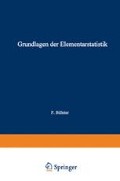Zusammenfassung
Die Statistik befaßt sich mit Massenerscheinungen. Dabei stellt sie auf die Häufigkeiten bestimmter Merkmale ab, die in einer aus Untersuchungsobjekten oder Elementen gebildeten Menge vorkommen. Das Element bildet also die Grundlage jeder statistischen Untersuchung. Es ist deshalb sehr wichtig, daß bei jeder statistischen Untersuchung das Element genau umschrieben wird, um Fehler zu vermeiden, die durch eine unklare Umschreibung des Elements entstehen könnten. Ein Element ist die einer bestimmten statistischen Untersuchung entsprechende und diesbezüglich kleinste und nicht weiter teilbare Zähleinheit. Ein solches Element kann je nach dem statistischen Untersuchungszweck eine Person, ein bestimmtes Produkt, ein Unfall usw. sein.
Access this chapter
Tax calculation will be finalised at checkout
Purchases are for personal use only
Preview
Unable to display preview. Download preview PDF.
Literaturverzeichnis
Banerjee, K. S.: Best Linear Unbiased Index Numbers and Index Numbers Obtained through a Factorial Approach (Econometrica, Vol. 31, No. 4, Oktober 1963, S. 712–718 ).
Banerjee, K. S.: A Factorial Approach to Construction of True Cost of Living Indexes and its Application in Studies of Changes in National Income (Sankhia, Series A, Vol. 23, P. 5, 3, 1961, S. 297–304 ).
Banerjee, K. S.: A Unified Statistical Approach to the Index Number Problem (Econometrica, Vol. 29, No. 4, Oktober 1961, S. 591–601 ).
Borticiewicz, L. voN: Das Gesetz der Kleinen Zahl (Leipzig 1898 ).
Burr, Irving W.: Cumulative Frequency Functions (Ann. Math. Statist., Vol. 13, 1942, S. 215–232 ).
Burr, Irving W., and Peter J. Cislak: On a General System of Distributions. I. Its Curve-shape Characteristics. II. The Sample Median (J. Amer. Statist. Ass., Vol. 63, No. 322, Juni 1968, S. 627–635 ).
Burr, Irving W.: On a General System of Distributions. Iii. The Sample Range (J. Amer. Statist. Ass., Vol. 63, No. 322, Juni 1968, S. 636–643 ).
Chisini, O.: Sul Concetto di Media (Periodico di Matematica, 1929).
DuBey, Satya D.: A Compound Weibull Distribution (Nay. Res. Logist. Quart., Vol. 15, No. 2, Juni 1968, S. 179–188 ).
Fisher, Irving: The Making of Index Numbers (Boston 1922).
Gini, Corrado: Quelques Considérations au Sujet de la Construction des Nombres Indices (Metron, Vol. 4, 1924, S. 3 ff.).
Graf, U., H.-J. Henning und K. Stange: Formeln und Tabellen der mathematischen Statistik (2. Aufl., Berlin—Heidelberg—New York 1966 ).
Kloej, T., and C. M. DE Wit: Best Linear and Best Linear Unbiased Index Numbers (Econometrica, Vol. 29, No. 4, Oktober 1961, S. 602–616 ).
Martinotti, P.: Di alcune recenti Medic (Acta Pontif. Acad. Sei., Vol. V, 1941 ).
Messedaglia, Angelo: Il Calcolo dei Valori Medi e le sue Applicazioni statistiche (Biblioteca dello Economista, Serie V, Vol. 19, 1908 ).
Theil, H.: Best Linear Index Numbers of Prices and Quantities (Econometrica, Vol. 28, No. 2, April 1960, S. 464–480 ).
Thiele, T. N.: Theory of Observations (London 1903, und Ann. Math. Statist., Vol. 2, 1931, S. 165 ff.).
Thorelli, Hans B., and William G. Himmelbauer: Executive Salaries: Analysis of Dispersion Patterns ( Metron, Vol. Xxvi, 1967, S. 114–149 ).
Schorer, H.: Statistik. Grundlegung und Einführung in die statistische Methode (Bern 1946 ).
Stuvel, C.: A New Index Number Formula (Econometrica, Vol. 25, No. 1, Januar 1957, S. 123–131 ).
Vergottini, M. DE, P. Battara, V. Amato e R. Mogno: Studi suite Relazioni Statistiche (Studi e Monografie Soc. Ital. Econ. Demograf. e Statist., No. 6, Rom 1952/53.
Weibull, Waloddi: Efficient Methods for Estimating Fatigue Life Distributions of Roller Bearings (Proc. Symp. on Rolling Contact Phenomena, General Motors Corp., 1960, S. 252–265 ).
Author information
Authors and Affiliations
Rights and permissions
Copyright information
© 1970 Springer-Verlag Wien
About this chapter
Cite this chapter
Billeter, E.P. (1970). Beschreibende Grundverfahren der Statistik. In: Grundlagen der Elementarstatistik. Springer, Berlin, Heidelberg. https://doi.org/10.1007/978-3-662-25698-5_3
Download citation
DOI: https://doi.org/10.1007/978-3-662-25698-5_3
Publisher Name: Springer, Berlin, Heidelberg
Print ISBN: 978-3-662-23619-2
Online ISBN: 978-3-662-25698-5
eBook Packages: Springer Book Archive

